All about the plant deytion pink
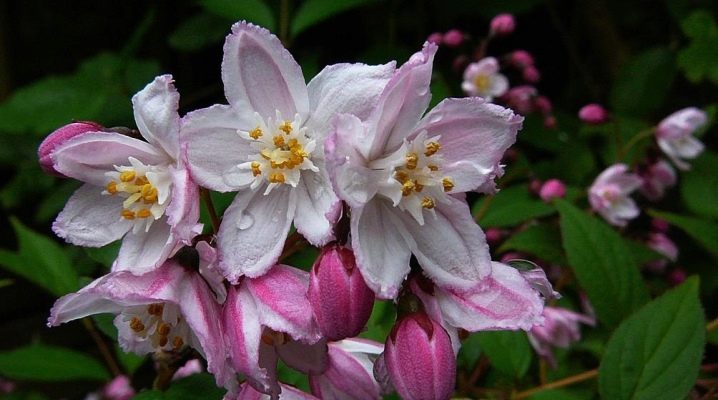
Shrub plants attract attention due to the splendor of the flowering. They are used to create compositions in landscape design or in a single accent. The action shrub is distinguished not only by the beauty of flowers and a variety of varieties, but also by its ease of care, ease of growing in the open field.
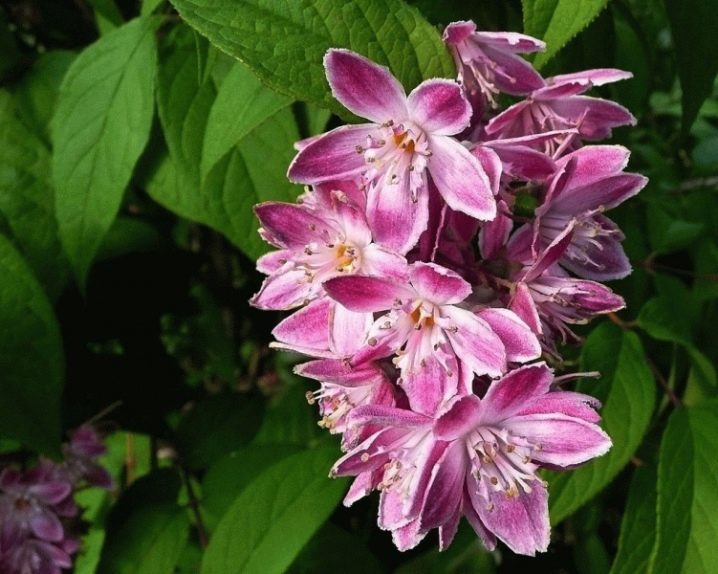
Shrub description
Deytsia is a member of the Hortensian family and belongs to a woody shrub. Botanical scientist Karl Peter Turbeng gave the plant the botanical name Deutzia. The main habitats of the culture are considered to be Central America and East Asia. Today, there are over two dozen species, they can be found both in the wild and in home areas. The decorative bush attracts attention due to its size, as well as unique bright flowers.
Deytsiya pink is one of the species in the family. The shrub has a weak growth force, it stretches very slowly. It is noted that in 4-8 years it grows in height by about 1 m. The crown width reaches 1.2-1.5 m. The crown shape in the natural environment is often spherical. But with the help of shaping, the bush can be given any shape.
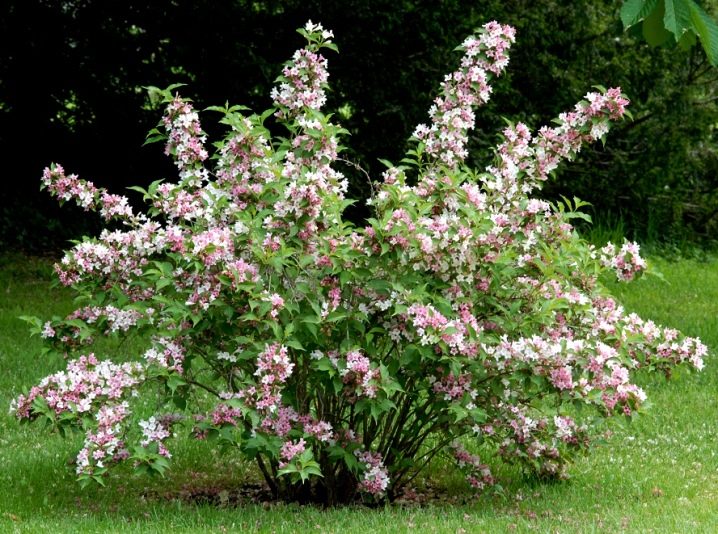
The shoots of the tree are brown, with a slight nutty tint. 2-3 years after planting, the trunk may begin to darken and become hollow inside. The leaves are elongated, ovoid or oval in shape. Dark green in color. The surface is covered with delicate hairs, some species have a smooth surface. The average length of the leaves is 8-10 cm.
The buds are collected in small loose clusters of inflorescences. They are bisexual, so you shouldn't worry about pollination. Many varieties have bell-shaped flowers, they reach no more than 5 cm in diameter. The petals in the buds are small, they are milky white in color on the inside, and on the outside they are usually pale pink. Some varieties that are hybrids have a more intense pink color.
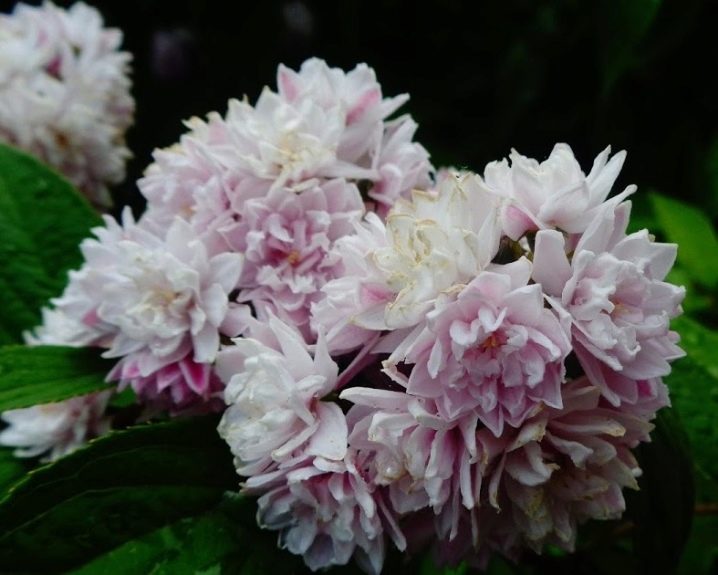
The root system consists of several pairs of single roots. They go straight down into the soil. The main root is always framed by a small ball of fibrous small root processes that diverge in different directions. The first flowering occurs 3 years after planting in a permanent place. The active flowering period in different regions starts from late May or early June and lasts until July-August.
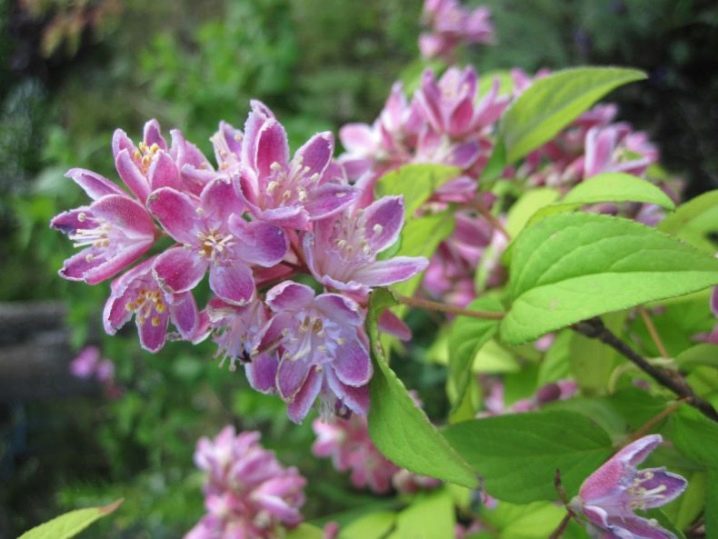
Varieties
Almost all varieties of deytion pink are hybrid plants. The first such crossing took place at the end of the 19th century. The resulting bushes were low, only up to 1.5 m. But the crown turned out to be quite spreading and very dense. Many summer residents say that the shoots form a small arch as they grow.

The flowers are also small, only 2 cm in diameter. The most striking representatives of pink action are the following varieties.
- "Campanulata" - a small bush that reaches a height of 1 m. The diameter of the crown is 0.8-1 m. The branches lean too much towards the ground. The bush is abundantly covered with leaves and flowers. The buds are small, white-pink in color, all of them are collected in numerous brushes. The beginning of flowering period is the 2nd decade of May.
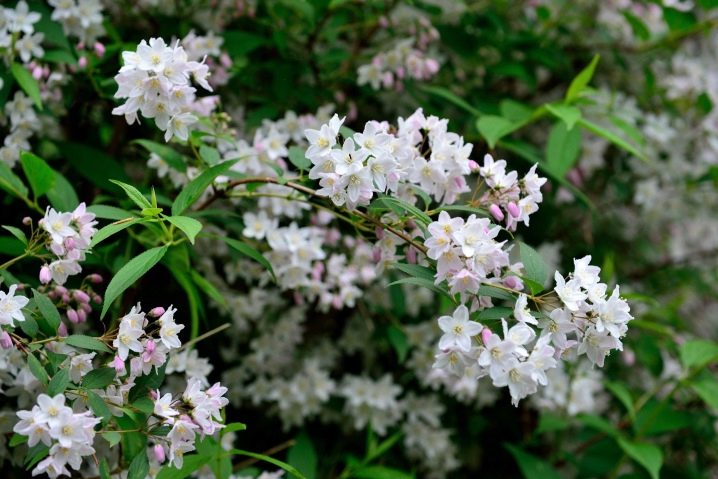
- "Pink Pom-Pom" - a hybrid shrub that belongs to the stellate or rough group. It appeared recently, around the beginning of the 2000s. Flowers are small, 1.5-2 cm in diameter. The inflorescences are large. Peduncles are bisexual, but odorless. The buds have double perianths with 5 petals. White predominates on the inside, but double pink on the outside.

- "Rosea Plena" considered the most beautiful type of action. Differs in late flowering from late July to late August. It has multi-tiered double buds of white-pink color. They are collected in bright and noticeable inflorescences, which are 10-12 cm long. Like the previous variety, this one does not smell at all. The bush has a height of 2.5 m, the crown spreads out to 1.5-2 m in width.
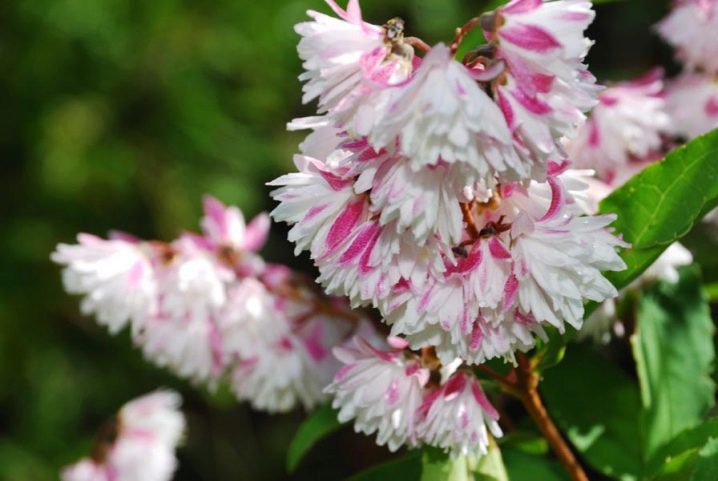
- "Pink Mountain" it is distinguished by abundant and lush flowering. Lateral shoots reach a length of 1.5 m and hang beautifully in different directions. Skeletal branches can stretch up to 1.8-2 m. Flowers have a pleasant pale pink color. The aroma is practically absent. A feature is that the variety tolerates low temperatures well down to -10 ° C. After unexpected frosts, it can recover on its own.
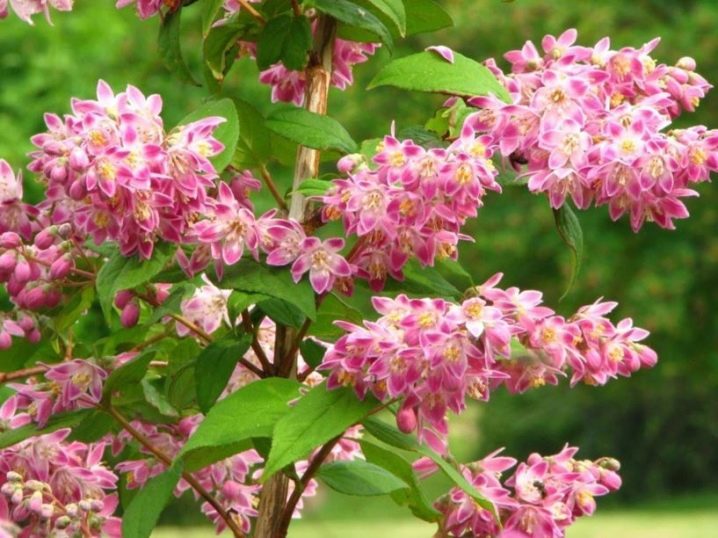
Other popular varieties of action pink are:
- "Tatiana";
- Strawberry Fields;
- Monte Rosa;
- "Candidissima".
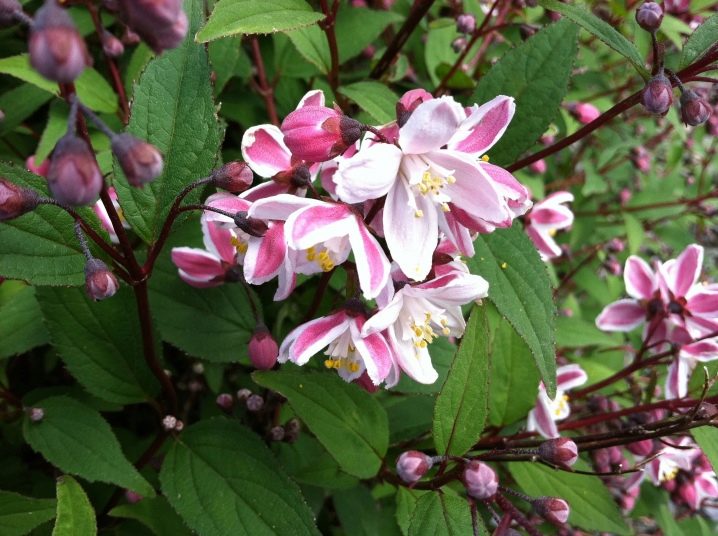
Landing
Planting and growing action is not difficult. The shrub is not very picky about the site, while it is very compact and does not grow so quickly... The best place to grow a plant is considered to be the sunny side, but a little partial shade is also allowed. The soil should be chosen neutral or slightly acidic, while the soil should be well saturated with moisture and be very loose.
Planting a young seedling can be carried out both in spring and autumn. In spring, planting is carried out from March to April, when active sap flow and color set have not yet begun.
In autumn, the plant is planted from late August to early November. In this case, you should wait until the foliage falls off.
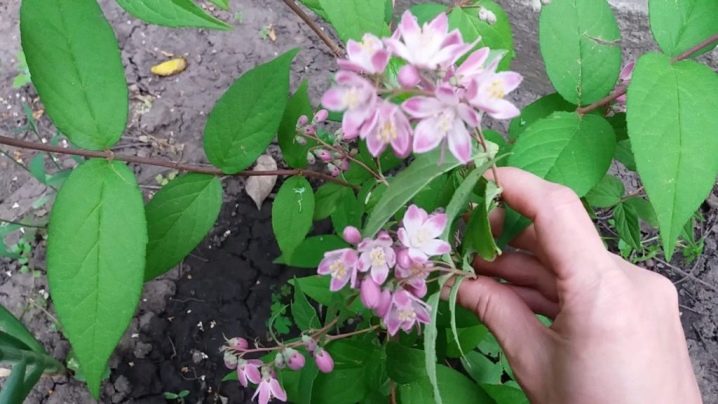
To properly land, the following points must be considered.
- The selected area is dug up, all weeds are removed. If necessary, mix the earth with a small amount of peat and sand.
- After that, a hole is dug with a diameter of at least 30 cm, and its depth should be from 40 cm.
- The bottom of the pit must be slightly loosened; this can be done with a hoe or a pitchfork. This little trick will allow the root system to go deeper into the soil faster.
- Before planting, the seedling is dipped into the water for 15-20 minutes.
- A small handful of earth is poured at the bottom of the hole, forming a mound. Then a seedling is lowered to this bottom. After the roots are straightened and gradually everything is covered with earth. The earth is compacted tightly around the trunk.
- Shoots must be shortened by 1/3. All dry and damaged branches should be removed.
- After planting, the seedling is watered abundantly with water. A couple of days after watering, the soil should be inspected, as it may settle or erode, exposing the roots. It is necessary to add the missing amount of earth.
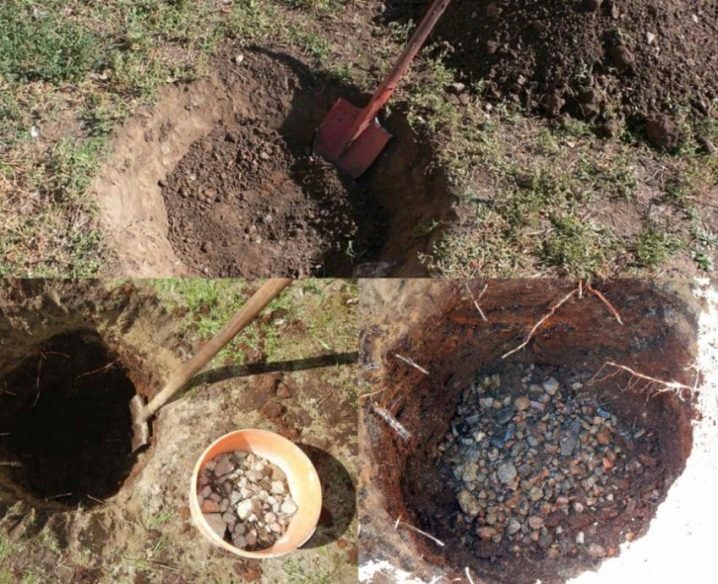
Care
When leaving, you should follow some rules of agricultural technology.
- Watering... The plant can easily tolerate a slight drought. But watering should be generous and abundant. The procedure should be carried out especially carefully when the buds begin to gain color. If there is not enough moisture, then the flowering will be short-lived and weak. And with severe depletion, the bush may not bloom at all.
- Pruning... It is done 2 times a year. In the spring, old dry branches are removed that did not leave after winter. In the fall, cut off those branches that bloomed profusely, by about 1/4. This will help the plant to grow more new shoots next year, thereby ensuring the growth of the crown.
- Top dressing... Action is undemanding to additional feeding, as it takes all the necessary substances from the ground. But it is recommended to apply liquid manure under the root once a year, as well as a complex of mineral fertilizers.
- Preparing for winter. Some varieties, especially hybrids, can tolerate light frosts with ease. But it is best to prepare a shelter, thereby protecting the bush. Young shoots are very easily covered with ice (from temperature changes) and may not leave in the spring.
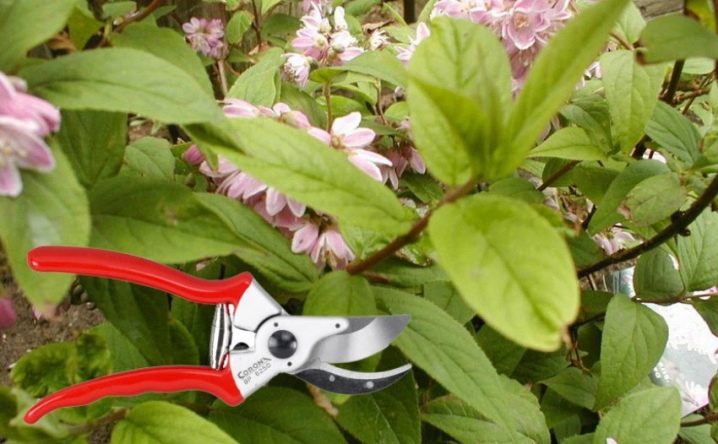
Reproduction
You can propagate pink action:
- cuttings;
- seeds;
- dividing the bush.
It is worth noting that most often gardeners resort to cuttings or dividing bushes.Seed propagation is rather laborious, therefore it is used in exceptional cases.
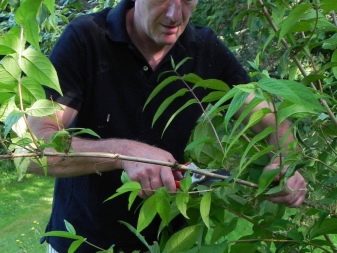


































































The comment was sent successfully.